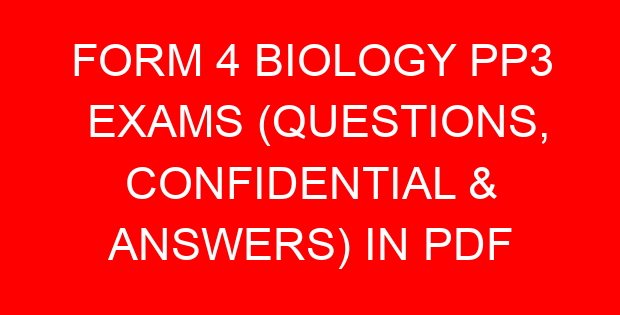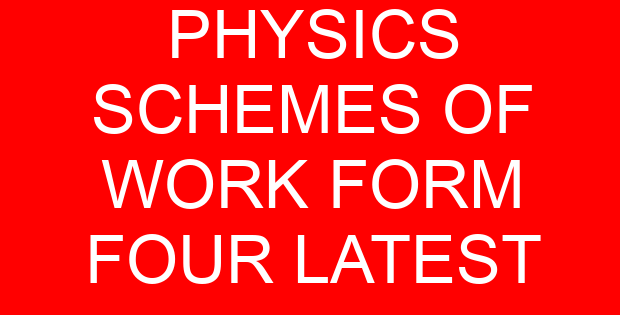FORM 4 BIOLOGY PP3 EXAMS (QUESTIONS, CONFIDENTIAL & ANSWERS) IN PDF
231/3
BIOLOGY
PAPER 3
KASSU
TIME: 2 HOURS
Kenya Certificate of Secondary Education (K.C.S.E.)
REQUIREMENTS FOR EACH CANDIDATE
- Solution P- starch
- Solution Q- egg white
- Solution Z- water
- Solution R- Diastase
- Benedict’s solution
- Iodine solution
- Visking tubing – 8cm
- Thread
- 100ml beaker
- 5 test tubes
- 5 labels
- D1-Blackjack
- D2-Sonchus
- D3-Jacaranda
- D4-Mango
Name………………………………………………… Adm no. ……………Class…….
School …………………………………………………
231/3
BIOLOGY
PAPER 3 (PRACTICAL)
Time: 1 ¾ HOURS
KASSU JET EXAMINATION –
231/3
BIOLOGY PAPER 3 (PRACTICAL)
Time: 1 ¾ HOURS
INSTRUCTIONS TO CANDIDATES
- Answer ALL the questions.
- You are required to spend the first 15 minutes of 1 ¾ hours allowed for this paper reading the whole paper carefully before commencing your work.
- Answers must be written in the spaces provided in the question paper.
- Additional pages must not be inserted.
FOR EXAMINERS USE ONLY
| Question | Maximum score | Candidate’s score |
| 1 | 12
|
|
| 2 | 14
|
|
| 3 | 14
|
|
| Total Score | 40
Marks |
This paper consists of 5 printed pages.Candidates should check the question paper to ensure that all pages are printed as indicatedand no questions are missing
- You are provided with the photomicrograph of an onion outer epidermis as seen under light microscope
- a) On the photograph, name parts labelled A, C, and D (3mark) A ……………………………………………………………
C ……………………………………………………………
D ……………………………………………………………
- Explain how the part labelled B is adapted to its function (2marks)
………………………………………………………………………………………………………………………………………………………………………………………………
- Calculate the actual size of the cell marked K, give your answer in micrometres
(2marks)
- The differences between the cells in the photograph and those obtained from an animal epithelial cells (3marks)
| Onion epidermal cells | Animal epithelial cells |
- State the process that make the structures in the cell above appear more distinct
(1mark)
………………………………………………………………………………………..
- In microscopic procedure in 1 (d) above name what was used to achieve the process
(1mark)
……………………………………………………………………………………………
- The photographs below represent specimen labeled A, B, C and D
| SPECIMEN A | SPECIMEN B |
| SPECIMEN C | SPECIMEN D |
- Name the type of placentation shown in specimen A and B (2marks)
A…………………………………………………………………………………
B…………………………………………………………..………………….…
- Identify the type of sections from which specimen C and D was obtained?
(2 marks)
C…………………………………………………………………………………
D…………………………………………………………..………………….…
- Classify the above specimen labeled D (1mark)
………………………………………………………………………………
- You are provided with specimen labeled D1, D2, D3 and D4. Examine them
Draw and label specimen labeled D2 (3marks)
- Giving a reason and state the agent of dispersal of the specimen (6marks)
| Specimen | Agent of dispersal | Reason |
| D1 |
|
|
| D3 |
|
|
| D4 |
|
- You are provided with the following. Solution P, Q and Z.
- (i) Put 2 cm3 of solution P into two test tubes labeled A and B. Add iodine solution drops into test tube A. Observe and record. (1 mark)
…………………………………………………………………………………………..
(ii)To test tube B, add an equal amount of Benedict’s solution. Heat to boil. Record your observation. (1 mark)
…………………………………………………………………………………………..
(iii) From the results in (a) (i) and (ii), identify solution P. (1 mark)
…………………………………………………………………………………………..
(iv). Put 2cm3 of solution Z into a clean test tube labelled C. Add equal volume of Benedict’s solution. Heat to boil. (1 mark)
……………………………………………………………………………………..……
(v) Open the visking tubing provided, Pour solution P into the visking tubing and add 1cm3 of the solution R. Tie the visking tubing and ensure there is no leakage. Pour solution Z into a clean beaker till it is half full. Immerse visking tube in the solution Z in the beaker. Allow it to stand for 30 minutes. After 30 minutes, take 2cm3 of solution Z from the beaker into a clean test tube labelled D. Add equal amount of Benedict’s solution. Heat to boil. Record your observation. (1 mark)
…………………………………………………………………………………………..
(vi)Account for the observation made in (v) above. (3 marks)
…………………………………………………………………………………………………………………………………………………………………………………………………………………………………………………………………………………………………………………………………………………………………………..
- i) Pour 2 cm3 of solution Q into a clean test tube. Observe and record the color of solution (1 mark)
…………………………………………………………………………………………
- ii) Add 1 cm3 of sodium hydroxide into test tube containing solution Q. Record your observation. (1 mark)
……………………………………………………………..……………………………
iii) Explain the results observed in (b)(ii) above. (2 marks)
………………………………………………………………………………………………………………………………………………………………………………………………………………………………………………………………….…………….
iv). what is the identity of solution R? (1 mark)
……………………………………………………………..……………………………v) State one factor that can affect the process demonstrated in 3a (v) above (1 mark)
……………………………………………………………..……………………………
KASSU BIOLOGY PAPER 3 MARKING SCHEME
1.You are provided with the photomicrograph of an onion outer epidermis as seen under light microscope
- a) On the photograph, name parts labelled A, C, and D (3marks)
A chloroplast ;
C cell membrane ;
D cytoplasm ;
- Explain how the part labelled Bisadapted to itsfunction (2marks)
Cellwallcontain the polysaccharide cellulose; thatgivemechanical support
- Calculate the actual size of the cellmarked K, giveyouranswer in micrometres
(2marks)
Mg = image size
Actual size
1500= 4.4×10,000 ;
Actual size
=44000
1500
=29.3um ; units
- The differencesbetween the cells in the photograph and thoseobtainedfrom an animal epithelialcells (3marks)
| Onionepidermalcells | Animal epithelialcells |
| Cellwallpresent | Cellwall absent ; |
| Chloroplastpresent | Chloroplast absent ; |
| Nucleus locatedat the periphery | Centralised nucleus ; |
- State the processthatmake the structures in the cellaboveappear more distinct (1mark)
Staining ;
- In microscopicprocedurein 1 (e) abovenamewhatwasused to achieve the process(1mark)
Iodinestain,;methyleneblue ;eosinacceptany one
- The photographs below represent specimen labeled A, B, C and D
| SPECIMEN A | SPECIMEN B |
| SPECIMEN C | SPECIMEN D |
- Name the type of placentation shown in specimen A and B (2 marks)
A Axile;
B free central;
- Identify the type of sections from which specimen C and D was obtained?
(2 marks)
Ccross section/transverse section;
- Longitudinal section;
- Classify the above specimen labeled D (1mark)
Succulent;
- You are provided with specimen labeled D1, D2, D3 and D4. Examine them
Draw and label specimen labeled D2 (3marks)
- Giving a reason and state the agent of dispersal of the specimen (6marks)
| Specimen | Agent of dispersal | Reason |
| D1 |
Animal ;
|
Have hook-like structures which stick on fur/clothes of passing animals; |
| D3 |
Wind;
|
Has wing like structures to increase surface area for it to be carried by wind; |
| D4 |
Animal ;
|
Brightly coloured, succulent to attract animals that feed on it; |
- You are provided with the following. Solution P, Q and Z.
- (i) Put 2 cm3 of solution P into two test tubes labeled A and B. Add iodine solution drops into test tube A. Observe and record. (1 mark)
Blue-black colour observed;
(ii)To test tube B, add an equal amount of Benedict’s solution. Heat to boil. Record your observation. (1 mark)
Blue-black of Benedict’s solution persist;
(iii) From the results in (a) (i) and (ii), Identify solution P. (1 mark)
Starch solution;
(iv) put 2cm3 of solution Z into a clean test tube labelled C. Add equal volume of Benedicts solution. Heat to boil. (1 mark)
Blue colour of Benedict’s solution persist;
(v) Open the visking tubing provided. Pour solution P into the visking tubing and add 1cm3 of the solution R. Tie the visking tubing and ensure there is no leakage. Pour solution Z into a clean beaker till it is half full. Immerse visking tube in the solution Z in the beaker. Allow it to stand for 30 minutes. After 30 minutes, take 2cm3 of solution Z from the beaker into a clean test tube labelled D. Add equal amount of Benedict’s solution. Heat to boil. Record your observation. (1 mark)
Colour changes from Blue-green- yellow- orange;
(vi)Account for the observation made in (v) above. (3 marks)
Starch is hydrolysed into maltose by enzyme diastase; maltose molecules are small enough to diffuse through the small pores of the visking tubing; maltose reacted with Benedict’s solution producing an orange colour;
- (i)Pour 2 cm3 of solution Q into a clean test tube. Observe and record the color of solution Q. (1 mark)
White/turbid/ cloudy;
(ii)Add 1 cm3 of sodium hydroxide into test tube containing solution Q. Record your observation. (1 mark)
Solution Q clears/ white colour fades off;
(iii)Explain the results observed in (b)(ii) above. (2 marks)
` Sodium Hydroxide breaks down the protein molecules into peptides; peptides form a clear solution;
iv). what is the identity of solution R? (1 mark)
Enzyme/diastase
- v) State one factor that can affect the process demonstrated in 3a (v) above (1 mark)
Increase in temperature




